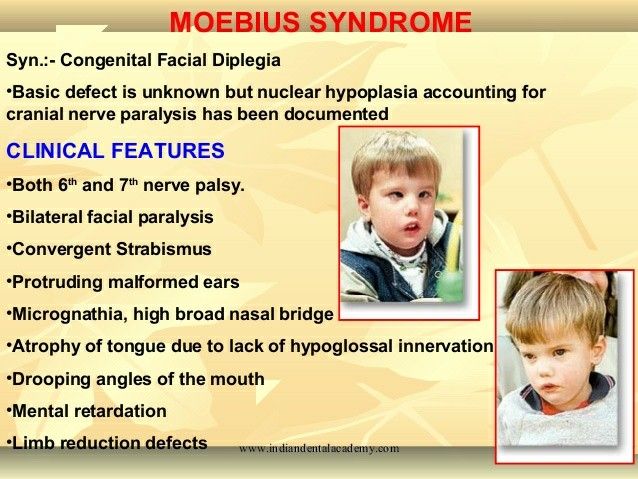What is Moebius syndrome?
Moebius syndrome is a rare neurological condition that primarily affects the muscles that control facial expression and eye movement. The signs and symptoms of this condition are present from birth. Other cranial nerves are sometimes affected.
If the 7.VII Facial nerve(Taste, tears, saliva, facial expressions) is involved, the person with Moebius syndrome is unable to smile, frown, pucker the lips, raise the eyebrows, or close the eyelids. If the 6.VI Abducens (Moves eyeballs) nerve is affected, the eye cannot turn outward and past the midline.
The muscle weakness also causes problems with feeding that become seen in early infancy.
According to rarediseases.org, Congenital facial and abducens palsy was first described by Von Graefe (1880) and Moebius (1888), a German neurologist after whom the syndrome was later named. Other abnormalities of the disease include underdevelopment of the pectoral muscles and defects of the limbs. Moebius syndrome is not progressive. The exact cause is unknown. It appears to occur randomly (sporadically) in some cases families suggest that there may be a genetic component.
Many patients with Moebius syndrome is born with a small chin (micrognathia) and a small mouth (microstomia) with a short or unusually shaped tongue. The roof of the mouth may have an abnormal opening (cleft palate) or be high and arched. These abnormalities contribute to problems with speech, which occur in many children with Moebius syndrome. Dental abnormalities, including missing and misaligned teeth, are also common.
Signs & Symptoms Moebius Syndrome
The abnormalities and severity of Moebius syndrome vary from person to person. The classically accepted diagnostic criteria include: 1) facial paralysis or weakness affecting at least one but usually both sides of the face (7th cranial nerve), 2) paralysis of sideways (lateral) movement of the eyes (6th cranial nerve); and 3) preservation of vertical movements of the eyes. Less often, other cranial nerves, including the 5th, 8th, 9th, 10th, 11th, and 12th may be affected too.
Cranial Nerves and their functions
The cranial nerves are the 12 pairs of nerves that leave the brain via their own individual apertures in the skull.
List of the Cranial Nerves
- I Olfactory (Smell)
- II Optic (Sight)
- III Oculomotor (Moves eyelid and eyeball and adjusts the pupil and lens of the eye)
- IV Trochlear (Moves eyeballs)
- V Trigeminal (Facial muscles incl. chewing; Facial sensations)
- VI Abducens (Moves eyeballs)
- VII Facial (Taste, tears, saliva, facial expressions)
- VIII Vestibulocochlear (Auditory)
- IX Glossopharyngeal (Swallowing, saliva, taste)
- X Vagus (Control of PNS e.g. smooth muscles of GI tract)
- XI Accessory (Moving head & shoulders, swallowing)
- XII Hypoglossal (Tongue muscles – speech & swallowing)
More information about the names, numbers, and functions of the 12 cranial nerves is summarized on this website: vyroses. com
Infants with Moebius syndrome may drool excessively and exhibit crossed eyes (strabismus). Because the eyes do not move from side-to-side (literally), the child is forced to turn the head to follow objects. Affected infants may also have difficulties feeding, including problems swallowing and poor sucking. Also, Corneal ulceration may occur because the eyelids remain open during sleep.
According to Moebius syndrome organization, Some affected children exhibit a delay in attaining certain milestones such as crawling or walking, most likely due to upper body weakness; however, most children eventually catch-up. Moebius syndrome rarely is associated with minor intellectual disability. Some children have been classified as being on the “autistic spectrum”. The exact relationship between Moebius syndrome and autism is unknown.
Some studies have suggested that autism spectrum disorders occur with greater frequency in children with Moebius syndrome; other studies have not confirmed this and suggest that any such relationship is overstated. Moebius syndrome is often associated with a variety of social and psychological consequences. The lack of facial expressions and the inability to smile can cause medical professionals to misinterpret what an affected patient is thinking or feeling or intends. Although clinical anxiety and depression are not more common in children and adolescents with Moebius syndrome, the affected patient may avoid social situations due to apprehension and frustration.
Causes of Moebius Syndrome
Most cases of Moebius syndrome occur randomly for unknown reasons (sporadically) in the absence of a family history of the disorder.
In rare cases, familial patterns have been reported. Most likely, Moebius syndrome is multifactorial, which means that both genetic and environmental factors play some causative role. It is possible that in different cases there are different underlying causes (heterogeneity).
In familial cases, there is evidence that Moebius syndrome is inherited as an autosomal dominant trait. Dominant genetic disorders occur when only a single copy of an abnormal gene is necessary for the appearance of the disease. The abnormal gene can be inherited from either parent or can be the result of a new mutation (gene change) in the affected individual. The risk of passing the abnormal gene from affected parent to offspring is 50% for each pregnancy regardless of the sex of the resulting child.
The spectrum of findings in Moebius syndrome suggests a developmental defect of the hindbrain. Several different theories have been proposed to explain the cause of Moebius syndrome. One hypothesis is the disorder is the result of diminished or interrupted blood flow (ischemia) to the developing fetus during pregnancy (in utero). Recent research suggests that the lack of blood affects certain areas of the lower brainstem that contain the cranial nerve nuclei. This lack of blood flow could result from an environmental, mechanical or genetic cause. Nevertheless, the cause of the syndrome remains inconclusive and more basic and clinical research is necessary.
Diagnosis
A diagnosis of the syndrome is based upon the characteristic signs/symptoms, a detailed patient history, and thorough clinical evaluation. There are no diagnostic tests that confirm a diagnosis of Moebius syndrome. Some specialized tests may be performed to rule out other causes of facial palsy.
Treatment of Moebius Syndrome
The treatment of the syndrome is directed toward the specific abnormalities in each individual. Usually, these children are managed by a multidisciplinary team, often in a craniofacial center. Involved specialists include pediatricians; neurologists; plastic surgeons; ear, nose, and throat specialists (otolaryngologists); orthopedists; dental specialists; speech pathologists; specialists who assess and treat hearing problems (audiologists), specialists who treat eye abnormalities (ophthalmologists) and other healthcare professionals.
Corrective procedures for facial paralysis involve the transfer of muscle and/or graft nerves from another area of the face or the body. An old procedure, known as temporalis tendon transfer, involves taking the temporalis muscle, one of the muscles normally used for chewing (mastication), and transferring it to the corners of the mouth. This same type of operation can be also used to improve closure of the eyelids. If the paralysis is on only one side (unilateral), a “cross-facial nerve graft” is an option. The procedure involves taking a sensory nerve from the calf, attaching it to a branch of the functioning facial nerve on the normal side of the face and then waiting until the regenerating nerve fibers cross over the face to reach the paralyzed side where it is joined to a motor nerve of a thin muscle transferred to the face by microvascular anastomosis.
The most recent procedure, called “the smile operation”, involves the microvascular transfer of a muscle from the thigh (gracillis) to the face and connecting the nerves that normally supply the masseter muscle (one of the muscles used for chewing). This operation has shown remarkable results in terms of speech, facial mobility, and self-esteem. Frequent lubrication for dry eyes is often necessary.
Physical therapy may be needed for individuals with various orthopedic abnormalities. Occupational therapy may also be beneficial, especially in patients with abnormalities of the hands, fingers, and toes. Speech therapy may be necessary for some affected children
RELATED READING
- Donate: Moebius Syndrome Foundation
- Progeria: Causes, Symptoms, and Treatment
- Foreign Accent Syndrome (FAS): Causes,Treatment, and Prevention
References
- Moebius Syndrome Organization. Rarediseases Organization
- Us National Library of Medicine. ghr.nlm.nih.gov
- College of Medicine, University of Ibadan, Nigeria, and others

Isreal olabanji a dental assistant and public health professionals and has years of experience in assisting the dentist with all sorts of dental issues.
We regularly post timely and trustworthy medical information and news on Fitness, Dental care, Recipes, Child health, obstetrics, and more.
The content is intended to augment, not replace, information provided by your clinician. It is not intended nor implied to be a substitute for professional medical advice. Reading this information does not create or replace a doctor-patient relationship or consultation. If required, please contact your doctor or other health care provider to assist you to interpret any of this information, or in applying the information to your individual needs.




